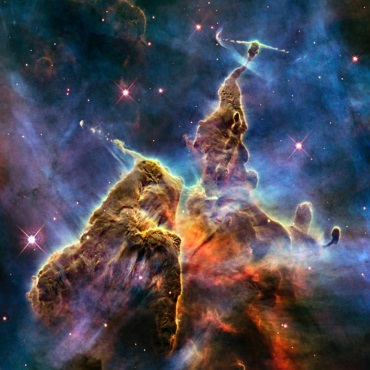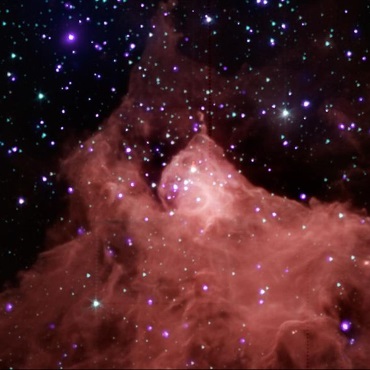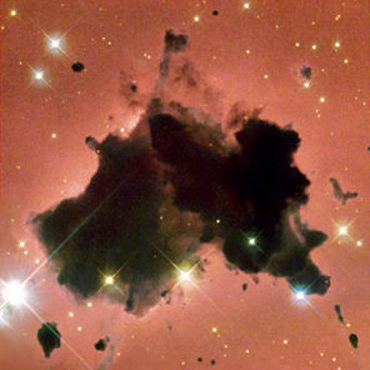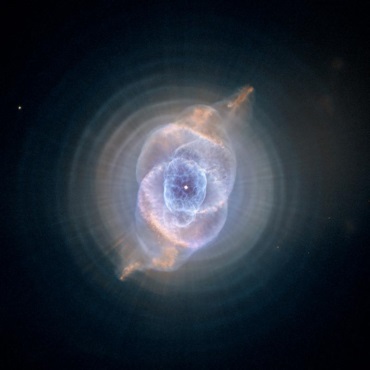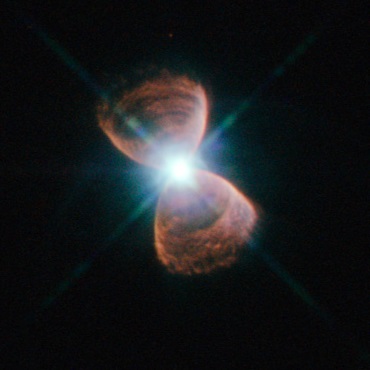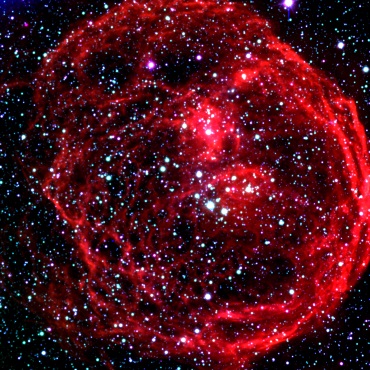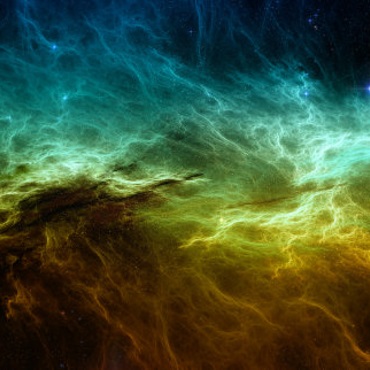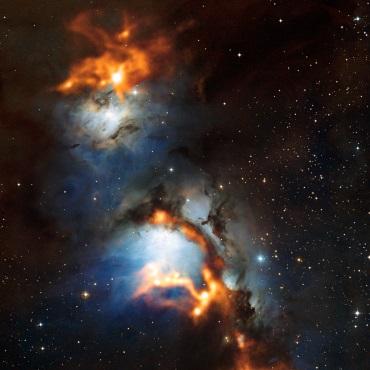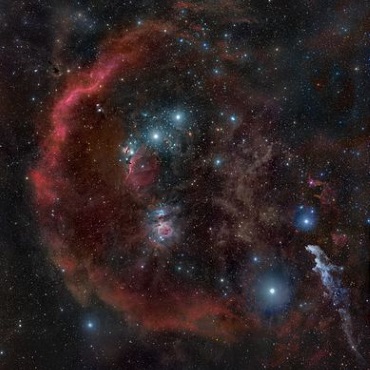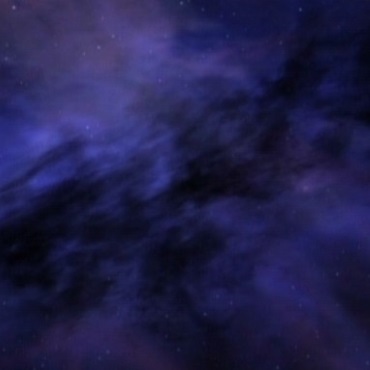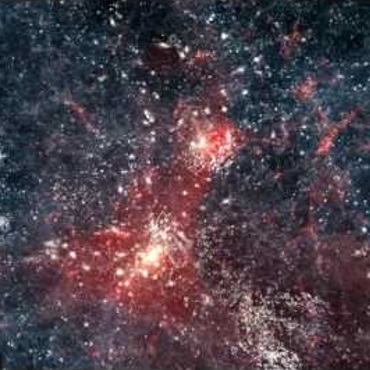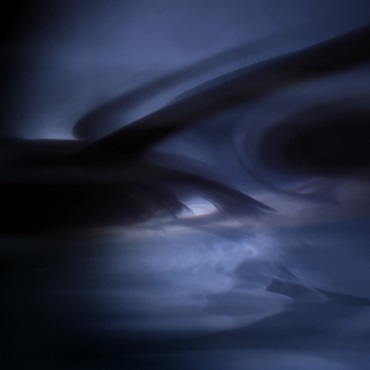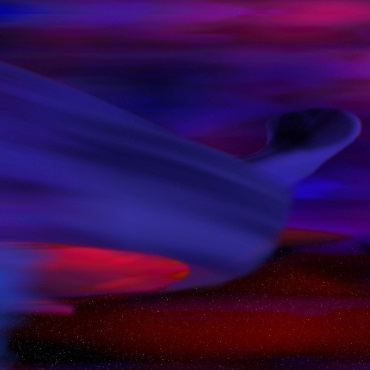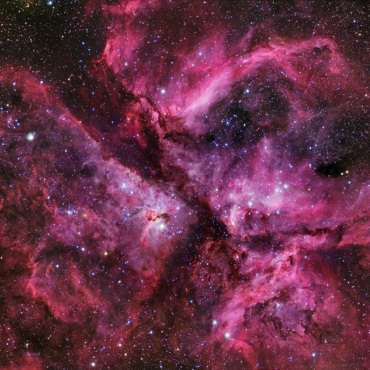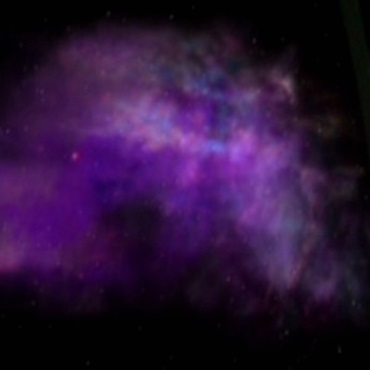Nebula Classifications
Created by Commodore Da`nal of the House of Varal on 13 Aug 2015 @ 2:39am
| A Nebula is and interstellar cloud of dust, gas, plasma, and other trace elements were star and planet formation can take place. There are Four categories of Nebulae, within these categories are various classes based on varying characteristics. | ||
Emission Nebula: | ||
 | ||
Class A: H II Region | |||
|
An H II region is a large stellar nursery, typically located inside an emission nebula. Over the duration of its lifespan, an H II region can give birth to thousands of stars. Gravimetric forces by the larger stars will eventually disperse the nebula and leave behind a star cluster similar to the Pleiades. | ||
| COMPOSITION: | Hydrogen, Helium, Oxygen, Ionized gases or Plasma. Can also contain a wide variety of other elements depending on the previous stellar generation. | ||
| AVERAGE SIZE: | 20 - 5,000+ ly | ||
| AVERAGE TEMP: | 10 - 20 K | ||
| LIFESPAN: | 1 - 5+ million years | ||
| EXAMPLE: | Eagle Nebula, Orion Nebula, NGC 604 | ||
| . | |||
| . | |||
Class A-1: Evaporating Gas Globule | |||
|
An evaporating gas globule is a region of hydrogen gas in outer space approximately 100 astronomical units in size, such that gases shaded by it are shielded from ionizing UV rays. Dense areas of gas shielded by an evaporating gas globule can be conducive to the birth of stars. | ||
| EXAMPLE: | Found in H II regions like the "Pillars of Creation"----------------- | ||
| . | |||
| . | |||
| . | |||
| . | |||
| . | |||
| . | |||
Class A-2: Molecular Cloud | |||
|
A molecular cloud, sometimes called a stellar nursery (if star formation is occurring within), is a type of interstellar cloud, the density and size of which permit the formation of molecules, most commonly molecular hydrogen. This is in contrast to other areas of the interstellar medium that contain predominantly ionized gas. | ||
| EXAMPLE: | Circinus Cloud, Barnard 68, Cepheus B-------------------------------- | ||
| . | |||
| . | |||
| . | |||
| . | |||
| . | |||
| . | |||
| . | |||
Class B: Bok Globule | |||
|
While an H II region can span light years and contain dozens of stars in varying states of development, Bok Globules are dense clusters of dust and gas, within an H II Region, where star formation actually takes place. They commonly result in binary and trinary star systems. | ||
| COMPOSITION: | Molecular Hydrogen, Carbon Oxides, Helium, Silicate dust.--------- | ||
| AVERAGE SIZE: | 100 AU - 1 ly | ||
| AVERAGE TEMP: | 3 K | ||
| LIFESPAN: | 1 - 2 million years | ||
| EXAMPLE: | Thackeray's Globules, The Caterpillar | ||
| . | |||
| . | |||
| . | |||
Class C: Solar aka Protostellar Nebula | |||
|
While most stars form within emission nebulas, there are exceptions to the rule. When a young star forms elsewhere, gravimetric forces gradually attract a disk of dust and gas that flatten to form a new star system that includes planets and asteroids. | ||
| COMPOSITION: | Hydrogen, Helium, Oxygen, Ionized gases or Plasma and can also contain a vast array of other element. The type of elements available depend on what was ejected into the interstellar medium from previous generations of stars. | ||
| AVERAGE SIZE: | 0.75 ly | ||
| AVERAGE TEMP: | 150 K | ||
| LIFESPAN: | 2 million years | ||
| EXAMPLE: | McAllister C-5 Nebula | ||
| . | |||
| . | |||
Class D: Wolf-Rayet Nebula | |||
|
A Wolf-Rayet nebula forms when strong stellar winds cause a Class O star to rapidly lose its mass. The dispersed mass forms a nebulous halo around the star. | ||
| COMPOSITION: | Hydrogen------------------------------------------------------------ | ||
| AVERAGE SIZE: | 0.5+ ly | ||
| AVERAGE TEMP: | 30,000 - 200,000 K | ||
| LIFESPAN: | 1 - 2 million years | ||
| EXAMPLE: | NGC 6888, NGC 2359 | ||
| . | |||
| . | |||
| . | |||
Class E: Protoplanetary Nebula | |||
|
A Protoplanetary Nebula is an astronomical object which is at the short-lived episode during a star's rapid stellar evolution between the late asymptotic giant branch phase and the subsequent planetary nebula phase. A PPN emits strongly in infrared radiation, and is a kind of reflection nebula as well as an emission nebula. It is the second-from-the-last high-luminosity evolution phase in the life cycle of intermediate-mass stars. | ||
| COMPOSITION: | Hydrogen, Helium, Carbon, Nitrogen, Oxygen and Neon----------- | ||
| AVERAGE SIZE: | .5 ly | ||
| AVERAGE TEMP: | 5,000 K | ||
| LIFESPAN: | 5,000 - 10,000 years | ||
| EXAMPLE: | Westbrook Nebula, IRAS 20068+4051 | ||
| . | |||
| . | |||
| . | |||
Class F: Planetary Nebula | |||
|
Despite the name, planetary nebulas have nothing to do with planets. They are a kind of emission nebula consisting of an expanding glowing shell of ionized gas ejected from old red giant stars late in their lives. They are a relatively short-lived phenomenon, lasting a few tens of thousands of years, compared to a typical stellar lifetime of several billion years. A mechanism for formation of most planetary nebulae is thought to be the following: at the end of the star's life, during the red giant phase, the outer layers of the star are expelled by strong stellar winds. Eventually, after most of the red giant's atmosphere is dissipated, the exposed hot, luminous core emits ultraviolet radiation to ionize the ejected outer layers of the star. This plays a crucial role in the evolution of the galaxy, for the process returns material to the interstellar medium. | ||
| COMPOSITION: | Hydrogen, Helium, Carbon, Nitrogen, Oxygen and Neon---------- | ||
| AVERAGE SIZE: | 1 ly | ||
| AVERAGE TEMP: | 10,000 - 25,000 K | ||
| LIFESPAN: | 10,000 years | ||
| EXAMPLE: | Cat's Eye, Ring, And Helix Nebulas | ||
| . | |||
Class F-1: BiPolar Nebula | |||
|
A bipolar nebula is a distinctive nebular formation characterized by an axially symmetric bi-lobed appearance. Many, but not all, planetary nebulae exhibit an observed bipolar structure. It may be that the two types of nebulae are directly related, one preceding or superseding the other in the evolution of the nebula. | ||
| EXAMPLE: | PN Hb 12, Eta Carinae------------------------------------------------ | ||
| . | |||
| . | |||
| . | |||
| . | |||
| . | |||
| . | |||
Class G: Nova Remnant | |||
|
A nova remnant is made up of the material either left behind by the gigantic explosion of a star in a nova, or from the bubbles of gas blasted away in a recurrent nova. | ||
| COMPOSITION: | Primarily Hydrogen, Helium, Carbon, Neon, Oxygen, Silicon, Iron, and Ionized Plasma; but can contain some heavier elements. | ||
| AVERAGE SIZE: | 0.5 ly | ||
| AVERAGE TEMP: | 5,000 - 10,000 K | ||
| LIFESPAN: | 100 - 300 years | ||
| EXAMPLE: | GK Persei, T Pyxidis | ||
| . | |||
| . | |||
| . | |||
Class H: Supernova Remnant | |||
|
A supernova remnant is the resulting of the explosion of a star in a supernova. The supernova remnant is bounded by an expanding shock wave, and consists of ejected material expanding from the explosion, and the interstellar material it sweeps up and shocks along the way. | ||
| COMPOSITION: | Hydrogen, Helium, Carbon, Neon, Oxygen, Silicon, Iron, and Ionized Plasma. Can also contain: Nitrogen, Calcium, Argon, Deuterium, Sulfur, Chlorine, Argon, Sodium, Potassium, Calcium, Scandium, Titanium, Vanadium, Chromium, Manganese, Cobalt, Nickel, Gold, Platinum, Lead, or other elements. | ||
| AVERAGE SIZE: | 3 ly | ||
| AVERAGE TEMP: | 10,000,000 K | ||
| LIFESPAN: | 1 million years | ||
| EXAMPLE: | SN 1987A, Cygnus Loop, Crab Nebula | ||
| . | |||
| . | |||
Class H-1: Supebubble or Supershell Nebula | |||
|
A superbubble is a cavity which is hundreds of light years across, and is filled with 106 K gas blown into the interstellar medium by multiple supernovae, from O & B type stars, and stellar winds. The Solar System lies near the center of an old superbubble, known as the Local Bubble, whose boundaries can be traced by a sudden rise in dust extinction of stars at distances greater than a few hundred light years. Large enough superbubbles can blow through the entire galactic disk, releasing their energy into the surrounding galactic halo or even into the intergalactic medium. | ||
| EXAMPLE: | Henize 70,Orion-Eridanus, LHA 120-N 44------------------------------- | ||
| . | |||
| . | |||
| . | |||
| . | |||
| . | |||
| . | |||
Class I: Inversion | |||
|
Inversion nebulas are rare, highly unstable nebulas created by plasma strings and they typically burn out after a few years. The only know, stable, inversion nebula was found in the Delta Quadrant being artificially maintained. | ||
| COMPOSITION: | Ionized Plasma Strings---------------------------------------------- | ||
| AVERAGE SIZE: | 100 AU - 200 AU | ||
| AVERAGE TEMP: | 10,000 K | ||
| LIFESPAN: | 5 - 10 years | ||
| EXAMPLE: | ,Marayna Nebula (Delta Quadrant) | ||
| . | |||
| . | |||
| . | |||
Non-Emission Nebulae: |
Class J: Reflective Nebula | |||
|
Reflection Nebulae are clouds of interstellar dust which reflect the light of a nearby star or stars. The energy from the nearby stars is insufficient to ionize the gas of the nebula to create an emission nebula, but is enough to give sufficient scattering to make the dust visible. Thus, the frequency spectrum shown by reflection nebulae is similar to that of the illuminating stars. Among the microscopic particles responsible for the scattering are carbon compounds (e. g. diamond dust) and compounds of other elements such as iron and nickel. The latter two are often aligned with the galactic magnetic field and cause the scattered light to be slightly polarized. | ||
| COMPOSITION: | Hydrogen, Helium, Micrometre-sized dust particles, coated with frozen carbon monoxide and nitrogen, | ||
| AVERAGE SIZE: | 100 ly | ||
| AVERAGE TEMP: | 25,000 K | ||
| AVERAGE LIFESPAN: | 10 million - 10 billion years | ||
| EXAMPLE: | Witch Head Nebula, Homunculus Nebula (Eta Cainae), Messier 78 | ||
| . | |||
Class K: Dark Nebula | |||
|
A dark nebula or absorption nebula is a type of interstellar -cloud that is so dense it obscures the light from objects behind it, such as background stars and emission or reflection nebulae. The extinction of the light is caused by interstellar dust grains located in the coldest, densest parts of larger molecular clouds. Clusters and large complexes of dark nebulae are associated with Giant Molecular Clouds. Isolated small dark nebulae are called Bok globules. Like other interstellar dust or material, things it obscures are only visible using radio waves in radio astronomy or infrared in infrared astronomy. | ||
| COMPOSITION: | Hydrogen, carbon, iron, and nickel----------------------------- | ||
| AVERAGE SIZE: | 100 - 300 ly | ||
| AVERAGE TEMP: | 7 K | ||
| AVERAGE LIFESPAN: | 1 million - 2 million years | ||
| EXAMPLE: | Lupus 4, Horsehead Nebula, Cone Nebula | ||
| . | |||
| . | |||
Class L: Giant Molecular Clouds | |||
|
A vast assemblage of molecular gas with a mass of approximately 103 to 107 times the mass of a G type star is called a giant molecular cloud (GMC). Whereas the average density in the solar vicinity is one particle per cubic centimetre, the average density of a GMC is a hundred to a thousand times as great. Although a star is much more dense than a GMC, the volume of a GMC is so great that it contains much more mass than the Sun. The substructure of a GMC is a complex pattern of filaments, sheets, bubbles, and irregular clumps. | ||
| COMPOSITION: | Particulate matter, Hydrogen, and Helium. Can contain trace amounts of Molecular Hydrogen, Carbon Monoxide, and Ammonia | ||
| AVERAGE SIZE: | 15 - 600 ly | ||
| EXAMPLE: | Orion & Taurus Molecular Clouds, Sagittarius B2 | ||
| . | |||
| . | |||
| . | |||
| . | |||
Class M: Black Clusters | |||
|
A black cluster was a type of cluster that was created when numerous protostars collapsed in close proximity to one another. The result of this collective collapse was an area of space that absorbed energy and dangerously affected spacecraft systems. Prior to 2368, the Federation maintained reports from starships travelling through black clusters indicating sensor difficulties. | ||
| EXAMPLE: | Black Clusters near SB 514, Deep Space 3, and in Breen Space--------- | ||
| . | |||
| . | |||
| . | |||
| . | |||
| . | |||
| . | |||
Class N: Intergalactic Gas or Warm-Hot Intergalactic Medium | |||
|
The sparse, warm-to-hot (105 to 107 K) plasma that exists in the spaces between galaxies containing 40–50% of the baryons (that is, 'normal matter' which exists as plasma or as atoms and molecules, in contrast to dark matter) in the universe. | ||
| EXAMPLE: | Not visibly detectable. Most easily observed from the absorption or emission of ultraviolet and low energy X-ray radiation.--------- | ||
| . | |||
| . | |||
| . | |||
| . | |||
| . | |||
| . | |||
Class O: Dark Matter Nebula | |||
|
A dark matter nebula was a gaseous accumulation of material in space which could be extremely difficult to detect using conventional sensor technology. If the dark matter is in sufficient amount there and be gaps in the fabric of normal space causing normal matter to phase out of normal space. | ||
| EXAMPLE: | Robinson, Mar Oscura------------------------------------------------- | ||
| . | |||
| . | |||
| . | |||
| . | |||
| . | |||
Disruptive Nebulae: | ||
| Are nebula that contain disruptive magnetic fields, cosmic rays, & electromagnetic, or other forms of radiation. |
Class P: Pulsar Wind Nebula | |||
|
A nebula powered by the pulsar wind of a pulsar. At the early stages (first few thousands of years) of their evolution, pulsar wind nebulae are often found inside the shells of supernova remnants. However, pulsar wind nebulae have also been found around older pulsars whose supernova remnants have disappeared. Pulsar winds are composed of charged particles accelerated to relativistic speed by the rapidly rotating, superstrong magnetic field of the spinning pulsar. The pulsar wind streams into the interstellar medium, creating a standing shock wave, where it is decelerated to sub-relativistic speed. | ||
| EXAMPLE: | Crab, Vela, "Hand of God" Nebulas------------------------------------ | ||
| . | |||
| . | |||
| . | |||
| . | |||
| . | |||
Class Q: Mutara Nebula | |||
|
A nebula that contains high levels of static discharge and ionized gases; renders shields and sensors inoperable. | ||
| EXAMPLE: | Mutara, Charma Vortex, Paulson Nebula-------------------------------- | ||
| . | |||
| . | |||
| . | |||
| . | |||
| . | |||
Class Q-1: Swallow Nebula | |||
|
A type of Mutara nebula that is deadly to organic tissue and causes deterioration to technology from subnucleonic radiation | ||
| EXAMPLE: | Swallow Nebula (Delta Quadrant)-------------------------------------- | ||
| . | |||
| . | |||
| . | |||
| . | |||
| . | |||
Class R: Dichromatic Nebula | |||
|
Dichromatic nebula are interstellar gas clouds with intense gravimetric distortions. | ||
| EXAMPLE: | Dorias Cluster------------------------------------------------------- | ||
| . | |||
| . | |||
| . | |||
| . | |||
| . | |||
Categories: Stellar Cartography
